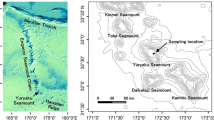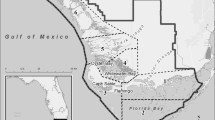Abtract
Syngnathus abaster andSyngnathus typhle (Pisces: Syngnathidae) from a dense Cymodocea nodesa meadow in the western Mediterranean Stagnone di Marsala (Italy) were studied using δ13N and δ15N analysis. Because of the presence of these two species in the same habitat and the specialized parental care by the male, the effect of species and sex on the isotopic composition was also studied to investigate the different feeding strategies between and within species.S. abaster andS. typhle exhibited enriched13C and15N values throughout the sampling period (mean ±SE, δ13C =−10.5±1.8‰ and−10.8±2.0‰, δ15N=11.9±0.7‰ and 10.6±1.0%., respectively), suggesting that these species receive their energy mainly from mixed sources, particularly from sedimentary and particulate organic matter and the seagrassC. nodosa as ultimate organic matter sources. ANOVA results demonstrated that the interaction between season, species, and sex significantly affected the isotopic composition of the pipefish (p<0.001 for both δ13C and δ15N). Differences between species and sex, although significant, were smaller than the values generally reported for trophic level differences (≈1‰ and ≈3.5‰ for δ15N, respectively) and change in foraging habitat, Slight isotopic differences may mirror small differences in resource exploitation and resource partitioning. Evidence from stomach content analysis from the literature coupled with stable isotope measurements, while disagreeing somewhat, provide additional knowledge of pipefish feeding strategies.
Similar content being viewed by others
Literature Cited
Berglund, A., G. Rosenqvist, andI. Svensson. 1986. Reversed sex roles and parental energy investment in zygotes of two pipefish (Syngnathidae) species.Marine Ecology Progress Series 29:209–215.
Bosley, K. L. andS. C. Wainright. 1999. Effects of preservatives and acidification on stable isotope ratios (15N:14N,13C:12C) of two species of marine animals.Canadian Journal of Fisheries and Aquatic Science 56:2181–2185.
Bunn, S. E., N. R. Loneragan, andM. A. Kempster. 1995. Effects of acid washing on stable isotope ratios of C and N in penaeid shrimp and seagrass: Implications for food-web studies using multiple stable isotopes.Limnology and Oceanography 40:622–625.
Campolmi, M., P. Franzoi, andA. Mazzola. 1996. Observations on pipefish (Syngnathidae) biology in the Stagnone lagoon (west Sicily).Publication Especiales Instituto Español de Oceanografia 21:205–209.
Chanton, J. P. andF. G. Lewis. 1999. Plankton and dissolved inorganic carbon isotopic composition in a river-dominated estuary: Apalachicola Bay, Florida.Estuaries 22:575–583.
Couch, C. A. 1989. Carbon and nitrogen stable isotopes of meiobenthos and their food resources.Estuarine, Coastal and Shelf Science 28:433–441.
Coull, B. C. 1990. Are members of the meiofauna food for higher trophic levles?Transaction of the American Microscopy Society 109:233–246.
Dauby, P. andM. Poulicer. 1995. Methods for removing epiphytes from seagrasses: SEM observations on treated leaves.Aquatic Botamy 52:217–228.
De Niro, M. J. andS. Epstien. 1977. Mechanism of carbon isotope fractionation associated with lipid synthesis.Science 197: 261–263.
Farquhar, G. D., J. R. Ehleringer, andK. T. Hubick. 1989. Carbon isotope discrimination and photosynthesis.Annual Review of Plant Physiology and Plant Molecular Biology 40:503–537.
Franzoi, P., R. Maccagnini, R. Rossi, andV. U. Ceccherelli 1993. Life cycles and feeding habits ofSyngnathus taenionotus andS. abaster (Pisces, Syngnathidae) in a brackish bay of the Po River Delta (Adriatic Sea).Marine Ecology Progress Series 97: 71–81.
Fry, B., S. A. Macko, andJ. C. Zieman. 1987. Riview of stable isotopic investigations of food webs in seagrass meadows, p. 117–138.In M. J. Durako, R. C. Phillips, and R. R. Lewis (eds.), Proceeding of a Symposium on Subtropical-Tropical Seagrases, South-east United States, Florida Department of Natural Resources, Bureau of Marine Research, St. Petersburg, Florida.
Gee, J. M. 1989. An ecological and economic review of meiofauna as food for fist.Zoological Journal of the Linnean Society 96:243–261.
Griffin, M. P. A. andI. Valifla. 2001 δ15N isotope studies of life history and tropic position ofFundulus heteroditus andMenidia menidia.Marine Ecology Progress Series 214:299–305.
Gronell, A. M. 1984. Courtship, spawning and social organization of the pipefishCorythoichthys intestinalis (Pisces: Syngnathidae) with notes no two congeneric species.Zeitschrift Tierpsychologie 65:1–24.
Harrigan, P., J. C. Zieman, andS. A. Macko. 1989. The base of nutritional support for the gray snapper (Lutjanus griseus): An evaluation based on a combined stomach content and stable isotope analysis.Bulletin of Marine Science 44:65–77.
Howard, R. K. andJ. D. Koehn. 1985. Population dynamics and feeding ecology of pipefish (Syngnathidae) associated with eelgrass beds of Western Port, Victoria.Australian Journal of Marine and Freshwater Resources 36:361–370.
Hyslop, E. J. 1980. Stomach contents analysis—A review of methods and their application.Journal of Fish Biology 17:411–429.
Klumpp, D. W., R. T. Howard, andD. Polllard. 1989. Trophodynamisc and nutritional ecology of seagrass communities, p. 394–457.In A. W. D. Larkum, A. J. McComb, and S. A. Sheper (eds.), Biology of Seagrases: A Treatise on the Biology of Seagrases with Special Reference to the Australian Region. Elsevier, Amsterdam, The Netherlands.
Lepoint, G., F. Nyssen, S. Gobert, P. Dauby, andJ. M. Bouquegneau. 2000. Relative impact of a seagrass bed and its adjacent epilithic algal community in consumer diets.Marine Biology 136:513–518.
Livingston, R. J. 1984. Trophic responses of fishes to habitat variability in coastal seagrass systems.Ecology 65:1258–1275.
Maberly, S. C., J. A. Raven, andA. M. Johnston. 1992. Discrimination between12C and13C by marine plants.Oecologia 91: 481–492.
Mauchline, J. 1969. The biology ofLeplomysis gracilis andL. lingvura (Crustacea, Mysidasea).Journal of the Marine Biological Association of the United Kingdom 49:379–389.
Mazzola, G., G. Sarà, F. Venezia, M. Caruso, D. Cataland, andS. Hauser. 1999. Origin and distribution of suspended organic matter as inferred from carbon isotope composition in a Mediterranean semi-enclosed marine system.Chemistry and Ecology 16:215–238.
Michener, R. H. andD. M. Schell. 1994. Stable isotope ratios as tracers in marine aquatic food webs, p. 138–157.In K. Lajtha and R. H. Michener (eds), Stable Isotopes in Ecology and Environmental Sciences. Blackwell Scientific Publications, Oxford, U.K.
Moncreiff, C. A. andM. J. Sullivan. 2001. Trophic importance of epiphytic algae in subtropical seagrass beds: Evidence from multiple stable isotope analyses.Marine Ecology Progress Series 215:93–106.
Pergent, G., J. Romero, C. Pergent-Martini, M. A. Mated, andC. F. Boundouresque. 1994. Primary production, stocks and fluxes in the Mediterranean seagrassPosidonia oceanica.Marine Ecology Progress Series 106:139–146.
Pinnegar, J. K. andN. V. C. Polunin. 1999. Differential fractionation of δ13C and δ15N among fish tissues: Implications for the study of trophic interactions.Functional Ecology 13:225–231.
Pinnegar, J. K. andN. V. C. Polunin. 2000. Contributions of stable-isotope data to elucidating food webs of Mediterranean rocky littoral fishes.Oecologia 122:399–409.
Ryer, C. H. 1988. Pipefish foraging: Effects of fish size, prey size and altered habitat complexity.Marine Ecology Progress Series 48: 37–45.
Ryer, C. H. andR. J. Orth. 1987. Feeding ecology of the northern pipefishSyngnathus fuscus in a seagrass community of the lower Chesapeake Bay.Estuaries 4:330–336.
Sarà, G., M. Leonardi, andA. Mazzola. 1999. Spatial and temporal changes of suspended organic matter in relation to wind and vegetation in a Mediterranean shallow coastal environment.Chemistry and Ecology 16:151–173.
Sclipoti, D. 1998. Studio della comunitã ittica resiedente all’interno dello Stagnone di Marsala (Sicilia occidentale): Distribuzione delle specie e ripartizione delle risorse in dipendenza di habitat a diversa complessità structturale. Ph.D. Dissertation. University of Messina, Messina, Italy.
Simenstad, C. A. andR. C. Wissmar. 1985. δ13C evidence of the origins and fates of organic carbon in estuarine and nearshore food webs.Marine Ecology Progress Series 22:141–152.
Steffe, A. S., M. Westoby, andJ. D. Bell. 1989. Habitat selection and diet in two species of pipefish from seagrass: Sex differences.Marine Ecology Progress Series 55:23–30.
Sullivan, M. J. andC. A. Moncreiff. 1990. Edaphic algae are an important component of salt marsh food-webs: Evidence from multiple stable isotope analyses.Marine Ecology Progress Series 47:31–43.
Underwood, A. J. 1997. Experiments in Ecology: Their Logical Design and Interpretation Using Analysis of Variance. Cambridge University Press, Cambridge, U.K.
Vizzini, S. andA. Mazzola. 2002. Stable carbon and nitrogen ratios in the sand smeltAtherima boyeri (Risso, 1810) (Osteichlthyes, Atherinidae) from a Mediterranean coastal area: Feeding habits and effect of season and size.Journal of Fish Biology 60:1498–1510.
Vizzini, S. andA. Mazzola. 2003. Seasonal variations in the stable carbon and nitrogen isotope ratios (15C/12C and15N/14N) of primary producers and consuments in a western Mediterranean coastal lagoon.Marine Biology 142:1009–1018.
Vizzini, S., G. Sarà, R. H. Michener, andA. Mazzola. 2002. The trophic role of the macrophyteCymodocea nodosa (Ucria) Asch in a Mediterrancean saltworls: Evidence from carbon and nitrogen stable isotope ratios.Bulletin of Marine Science 71: 1369–1378.
Watanabe, T., C. Kitajima, andS. Fujita. 1983. Nutritional values of live orgnaism used in Japan for mass propagation of fish: A review.Aquaculture 34:115–143.
Author information
Authors and Affiliations
Corresponding author
Rights and permissions
About this article
Cite this article
Vizzini, S., Mazzola, A. The trophic structure of the pipefish community (Pisces: Syngnathidae) from a western Mediterranean seagrass meadow based on stable isotope analysis. Estuaries 27, 325–333 (2004). https://doi.org/10.1007/BF02803388
Received:
Revised:
Accepted:
Issue Date:
DOI: https://doi.org/10.1007/BF02803388




